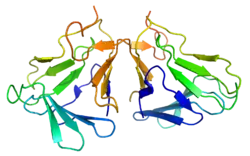Curculin
Curculin ist ein süß schmeckendes Protein, das in den Früchten der einkeimblättrigen malaiischen Pflanze Molineria latifolia (malaiisch Lumbah) aus der Familie der Hypoxidaceae vorkommt. Die Primärstruktur besteht aus 114 Aminosäuren.[1]
| Curculin-1 (Curculigo latifolia) | ||
|---|---|---|
 | ||
| Struktur des Homodimers nach PDB 2DPF | ||
|
Vorhandene Strukturdaten: 2DPF | ||
| Masse/Länge Primärstruktur | 114 Aminosäuren | |
| Sekundär- bis Quartärstruktur | Homo/Heterodimer | |
| Bezeichner | ||
| Gen-Name(n) | CUR09 | |
| Externe IDs | ||
Seine Süßkraft in Bezug auf Saccharose beträgt das 550-fache in 6,8%iger Lösung.[2] Der durch Curculin herbeigeführte süße Geschmack hält nur wenige Minuten an. Außerdem hat es die Eigenschaft, sauren Geschmack in einen süßen Geschmack zu verwandeln und ist somit ein Geschmackswandler (engl. taste modifier).
Einzelnachweise
- UniProt P19667
- H.-D. Belitz et al.: Lehrbuch der Lebensmittelchemie. 5. Aufl., Springer, Berlin u. a. 2001. S. 430 f.
Literatur
- H. Yamashita et al.: Purification and complete amino acid sequence of a new type of sweet protein taste-modifying activity, curculin. In: Journal of Biological Chemistry. 265(26), 1990, 15770–15775, PMID 2394746.
- E. Kurimoto et al.: Curculin exhibits sweet-tasting and taste-modifying activities through its distinct molecular surfaces. In: Journal of Biological Chemistry. 282(46), 2007, 33252–33256, PMID 17895249.
This article is issued from Wikipedia. The text is licensed under Creative Commons - Attribution - Sharealike. The authors of the article are listed here. Additional terms may apply for the media files, click on images to show image meta data.